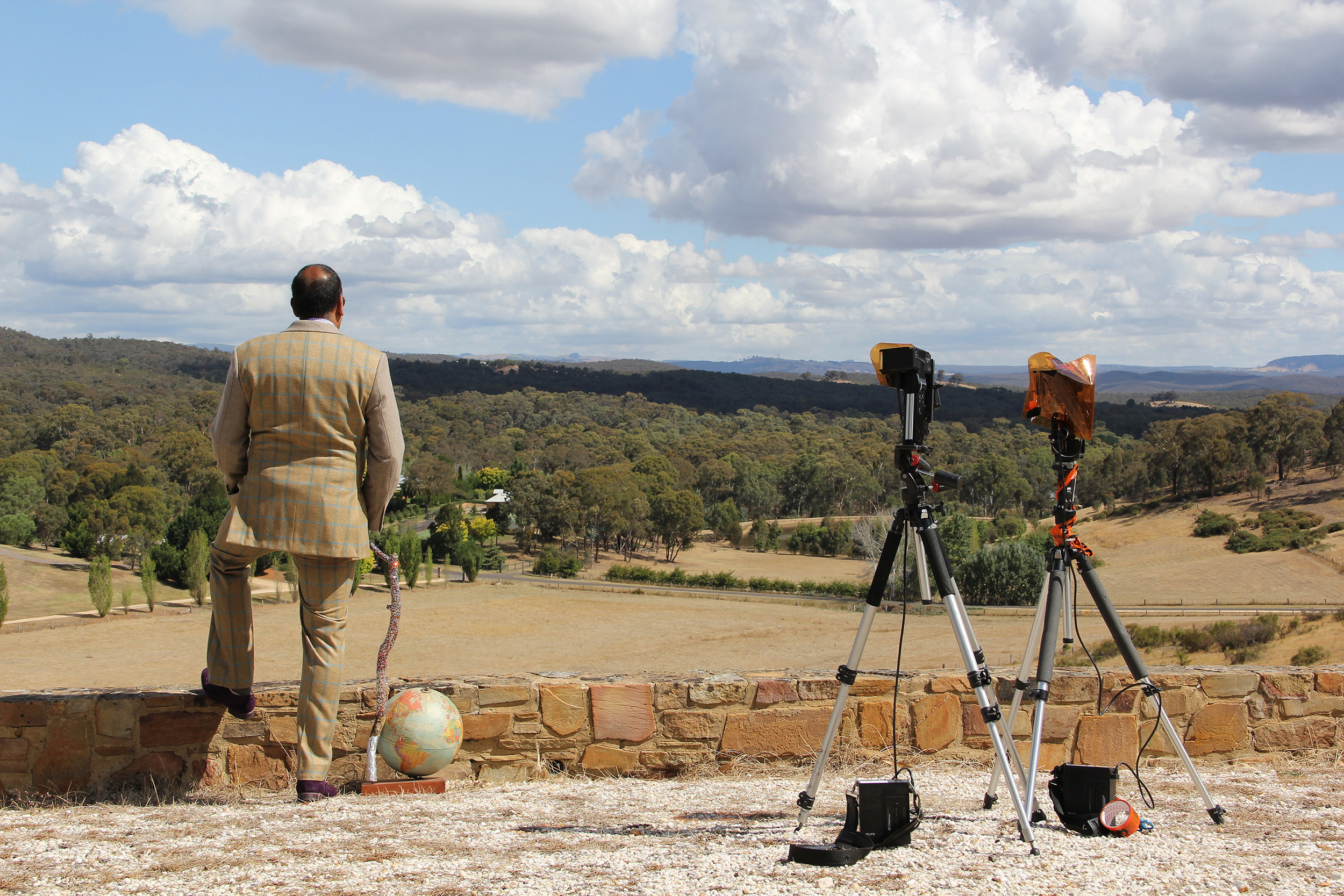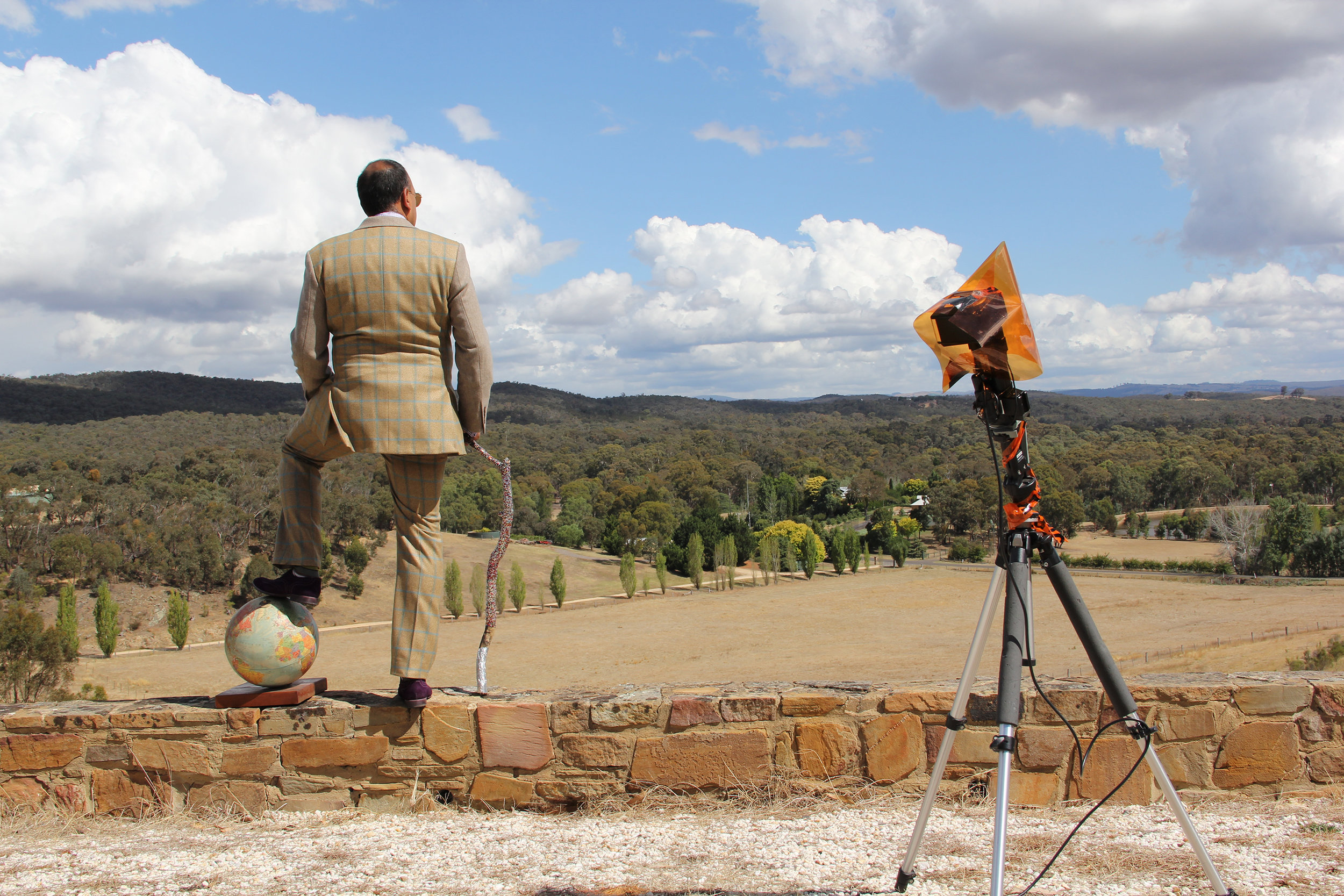Elsewhere (2013)
The photograph Elsewhere (2013) makes reference to ideas of power and world domination, themes central to the Imperialist project. Drawing on tropes from Wanderer above the Sea of Fog (1817–18), the protagonist in Elsewhere (2013), stands on the precipice of a man-made stone wall; one foot on a model globe, holding a eucalyptus branch covered in shimmering Swarovski crystals, surveying the landscape of the central goldfields of Victoria, Australia. He wears sunglasses to filter the harsh glare of the Australian light, so he can focus his gaze out to a distant point far across the horizon.
The photograph can be seen as a reenactment, or metaphor, of conquest The meaning in Elsewhere(2013) is intentionally slippery and layered. The viewer can read this work as a metaphor, or cliché, a pun or ironic, in relation to colonial conquests. The globe, with the protagonist’s foot resting on it, could be read as symbolising total control and domination. Maps and cartography were often used as imperialising strategies to claim, by registering empty space, therefore erasing any form of acknowledgement, of pre-existing knowledge, persons or culture (or acknowledging a presence perceived as being primitive). Conversely, can we read the image as claiming back territory and place by the Anglo Indian, mimicking and at the same time parodying, the quintessential colonialist Englishman? The protagonist can also come to represent the colonial male settler as the ambivalent figure. A figure who is both agent and beneficiary of the Imperial enterprise but ‘not a full member of the Imperial club back home’ (Lawson and Tiffin 1994, p. 231).
The protagonist in the photograph becomes indeterminate in terms of meaning, depending on who he is and what he represents. He wears the suit of the ‘in-between man’ becoming both coloniser and colonised. In this context, the protagonist and the artwork become dialogic, perpetuating an internalised dialogue extending in multiple directions, informing and being informed by past, present and future events, each influenced and influencing the next. Ultimately it is the interconnected space of multiplicity that the protagonist, the Anglo Indian artist, occupies as an extended experience of actual and imagined self.
The title of the photograph suggests the protagonist in the photograph imagines a place ‘elsewhere’ he cannot articulate or inhabit. Ultimately, Elsewhere(2013) becomes a space of displacement and un-belonging. A space somewhere across a distant horizon—home perhaps—a fractured space across platforms and landscapes, which operates in ways that can only be understood in a non-synchronous and atemporal way, mapping topologies with indeterminate borders and boundaries occurring simultaneously in time and space.
L to R 1 - 14
1 Elsewhere (2013) (Edition of 3), [inkjet photographic print on Hahnemühle FineArt Pearl paper 285 gsm; 110 cm x 148 cm (framed)
2 - 8 Preliminary test photographs for Elsewhere, on location at Fryerstown, Victoria. Images courtesy of Julie Millowick
9 - 14 Photographic documentation during the shooting of Elsewhere on location at Fryerstown, Victoria. Images courtesy of Marion Williams.
![D’Costa, R 2013, Elsewhere (Edition of 3), [inkjet photographic print on Hahnemühle FineArt Pearl paper 285 gsm 110 cm x 148 cm (framed)].](https://images.squarespace-cdn.com/content/v1/58f9c6fdbe6594f1c342a25c/1498646257592-PJK7HIK17T6MIPNEANCP/_JUL0268globe8+copyfinal.jpg)












